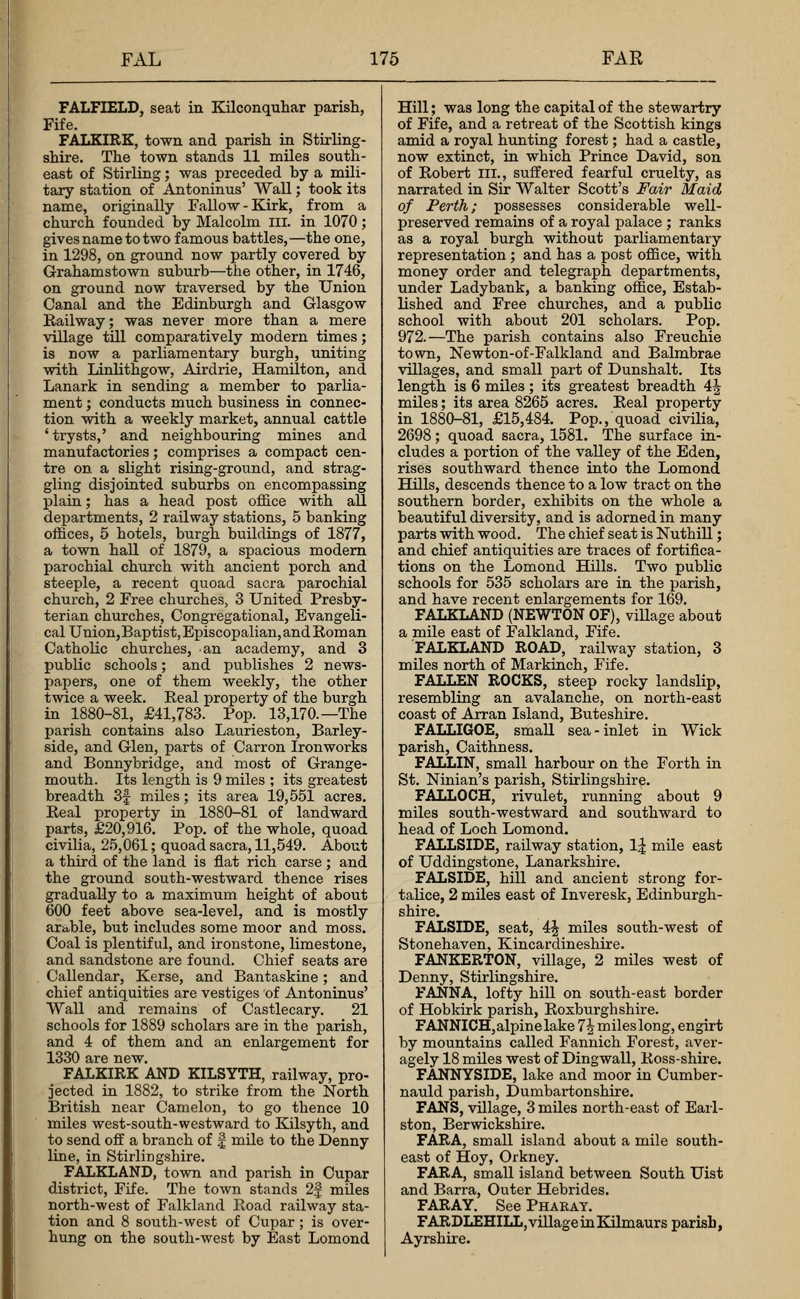FALFIELD, seat in Kilconquhar parish, Fife.
FALKIRK, town and parish in Stirlingshire. The town stands 11 miles south-east of Stirling ; was preceded by a military station of Antoninus' Wall ; took its name, originally Fallow-Kirk, from a church founded by Malcolm ill. in 1070 ; gives name to two famous battles, the one, in 1298, on ground now partly covered by Graham stown suburb the other, in 1746, on ground now traversed by the Union Canal and the Edinburgh and Glasgow Railway; was never more than a mere village till comparatively modern times ; is now a parliamentary burgh, uniting with Linlithgow, Airdrie, Hamilton, and Lanark in sending a member to parliament ; conducts much business in connection with a weekly market, annual cattle 'trysts,' and neighbouring mines and manufactories ; comprises a compact centre on a slight rising-ground, and straggling disjointed suburbs on encompassing plain ; has a head post office with all departments, 2 railway stations, 5 banking offices, 5 hotels, burgh buildings of 1877, a town hall of 1879, a spacious modern parochial church with ancient porch and steeple, a recent quoad sacra parochial church, 2 Free churches, 3 United Presbyterian churches, Congregational, Evangelical Union,Baptist, Episcopalian, and Roman Catholic churches, an academy, and 3 public schools; and publishes 2 news-papers, one of them weekly, the other twice a week. Real property of the burgh in 1880-81, 41,783. Pop. 13,170. The parish contains also Laurieston, Barleyside, and Glen, parts of Carron Ironworks and Bonnybridge, and most of Grangemouth. Its length is 9 miles ; its greatest breadth 3f miles ; its area 19,551 acres. Real property in 1880-81 of landward parts, 20,916. Pop. of the whole, quoad civilia, 25,061 ; quoad sacra, 11,549. About a third of the land is flat rich carse ; and the ground south-westward thence rises gradually to a maximum height of about 600 feet above sea-level, and is mostly arable, but includes some moor and moss. Coal is plentiful, and ironstone, limestone, and sandstone are found. Chief seats are Callendar, Kerse, and Bantaskine ; and chief antiquities are vestiges of Antoninus' Wall and remains of Castlecary. 21 schools for 1889 scholars are in the parish, and 4 of them and an enlargement for 1330 are new.
FALKIRK AND KILSYTH, railway, projected in 1882, to strike from the North British near Camelon, to go thence 10 miles west-south-westward to Kilsyth, and to send off a branch of f mile to the Denny line, in Stirlingshire.
FALKLAND, town and parish in Cupar district, Fife. The town stands 2f miles north-west of Falkland Road railway station and 8 south-west of Cupar ; is over-hung on the south-west by East Lomond Hill; was long the capital of the stewartry of Fife, and a retreat of the Scottish kings amid a royal hunting forest ; had a castle, now extinct, in which Prince David, son of Robert in., suffered fearful cruelty, as narrated in Sir Walter Scott's Fair Maid of Perth; possesses considerable well-preserved remains of a royal palace ; ranks as a royal burgh without parliamentary representation ; and has a post office, with money order and telegraph departments, under Ladybank, a banking office, Established and Free churches, and a public school with about 201 scholars. Pop. 972. The parish contains also Freuchie town, Newton-of-Falkland and Balmbrae villages, and small part of Dunshalt. Its length is 6 miles ; its greatest breadth 4J miles ; its area 8265 acres. Real property in 1880-81, 15,484. Pop., quoad civilia, 2698 ; quoad sacra, 1581. The surface includes a portion of the valley of the Eden, rises southward thence into the Lomond Hills, descends thence to a low tract on the southern border, exhibits on the whole a beautiful diversity, and is adorned in many parts with wood. The chief seat is Nuthill ; and chief antiquities are traces of fortifications on the Lomond Hills. Two public schools for 535 scholars are in the parish, and have recent enlargements for 169.
FALKLAND (NEWTON OF), viUage about a mile east of Falkland, Fife.
FALKLAND ROAD, railway station, 3 miles north of Markinch, Fife.
FALLEN ROCKS, steep rocky landslip, resembling an avalanche, on north-east coast of Arran Island, Buteshire.
FALLIGOE, small sea-inlet in Wick parish, Caithness.
FALLIN, small harbour on the Forth in St. Ninian's parish, Stirlingshire.
FALLOCH, rivulet, running about 9 miles south-westward and southward to head of Loch Lomond.
FALLSIDE, railway station, 1J mile east of Uddingstone, Lanarkshire.
FALSIDE, hill and ancient strong for-talice, 2 miles east of Inveresk, Edinburghshire.
FALSIDE, seat, 4 miles south-west of Stonehaven, Kincardineshire.
FANKERTON, village, 2 miles west of Denny, Stirlingshire.
FANNA, lofty hill on south-east border of Hobkirk parish, Roxburghshire.
FANNICH,alpinelake 1\ miles long, engirt by mountains called Fannich Forest, aver-ao-ely 18 miles west of Dingwall, Ross-shire.
FANNYSIDE, lake and moor in Cumbernauld parish, Dumbartonshire.
FANS, village, 3 miles north-east of Earlston, Berwickshire.
FARA, small island about a mile south-east of Hoy, Orkney.
FARA, small island between South Uist and Barra, Outer Hebrides.
FARAY.
FARDLEHILL, village in Kilmaurs parish, Ayrshire.

